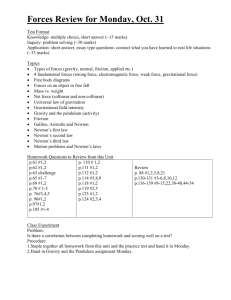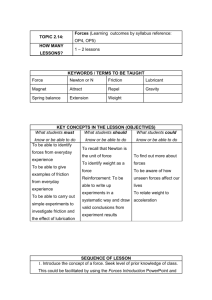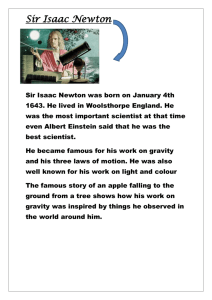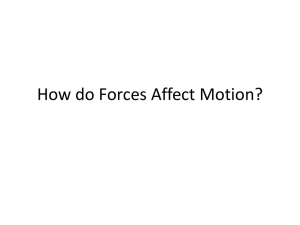STAGE 1 * DESIRED RESULTS
advertisement
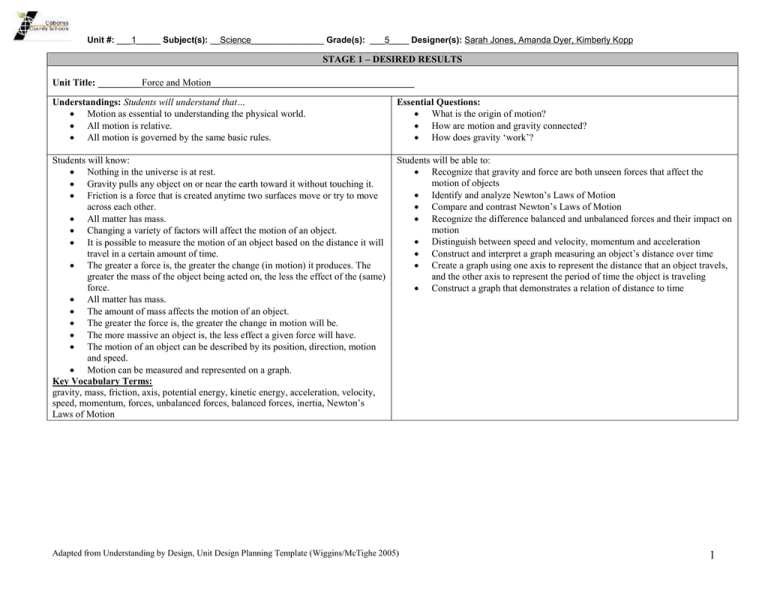
Unit #: ___1_____ Subject(s): __Science_______________ Grade(s): ___5____ Designer(s): Sarah Jones, Amanda Dyer, Kimberly Kopp STAGE 1 – DESIRED RESULTS Unit Title: _________Force and Motion__________________________________________ Understandings: Students will understand that… Motion as essential to understanding the physical world. All motion is relative. All motion is governed by the same basic rules. Essential Questions: What is the origin of motion? How are motion and gravity connected? How does gravity ‘work’? Students will know: Nothing in the universe is at rest. Gravity pulls any object on or near the earth toward it without touching it. Friction is a force that is created anytime two surfaces move or try to move across each other. All matter has mass. Changing a variety of factors will affect the motion of an object. It is possible to measure the motion of an object based on the distance it will travel in a certain amount of time. The greater a force is, the greater the change (in motion) it produces. The greater the mass of the object being acted on, the less the effect of the (same) force. All matter has mass. The amount of mass affects the motion of an object. The greater the force is, the greater the change in motion will be. The more massive an object is, the less effect a given force will have. The motion of an object can be described by its position, direction, motion and speed. Motion can be measured and represented on a graph. Key Vocabulary Terms: gravity, mass, friction, axis, potential energy, kinetic energy, acceleration, velocity, speed, momentum, forces, unbalanced forces, balanced forces, inertia, Newton’s Laws of Motion Students will be able to: Recognize that gravity and force are both unseen forces that affect the motion of objects Identify and analyze Newton’s Laws of Motion Compare and contrast Newton’s Laws of Motion Recognize the difference balanced and unbalanced forces and their impact on motion Distinguish between speed and velocity, momentum and acceleration Construct and interpret a graph measuring an object’s distance over time Create a graph using one axis to represent the distance that an object travels, and the other axis to represent the period of time the object is traveling Construct a graph that demonstrates a relation of distance to time Adapted from Understanding by Design, Unit Design Planning Template (Wiggins/McTighe 2005) 1 Unit #: ___1_____ Subject(s): __Science_______________ Grade(s): ___5____ Designer(s): Sarah Jones, Amanda Dyer, Kimberly Kopp 5.P.1 STAGE 1– Standards Understand force, motion and the relationship between them. 5.P.1.1 Explain how factors such as gravity, friction, and change in mass affect the motion of objects. 5.P.1.2 Infer the motion of objects in terms of how far they travel in a certain amount of time and the direction in which they travel. 5.P.1.3 Illustrate the motion of an object using a graph to show a change in position over a period of time. 5.P.1.4 Predict the effect of a given force or a change in mass on the motion of an object. 5.TT.1 Use technology tools and skills to reinforce and extend classroom concepts and activities. STAGE 2 – ASSESSMENT EVIDENCE Performance Tasks: Roller Coaster Performance Task: http://www.nsta.org/elementaryschool/connections/200804Capobianco.pdf Other Evidence: Formative Task 1: A & D Statements I Task 2: A & D Statements II Task 3: Odd One Out I Task 4: Odd One Out II Task 5: Sense or Nonsense Task 6: Three Words / One Sentence Task 7: Bouncing Ball Experiment Task 8: Forces on a Plane Uncovering Student Ideas in Science – Volume 1, “Talking About Gravity” pg. 97 Uncovering Student Ideas in Science – Volume 3, “Apple on the Desk” pg. 63 Uncovering Student Ideas in Science – Volume 3, “Rolling Marbles” pg. 71 Uncovering Student Ideas in Science – Volume 3, “Dropping Balls” pg. 77 Summative Task 9: EOG Review Assessment Task 10: Force and Motion Unit Test (Answer Key) Key Criteria: Adapted from Understanding by Design, Unit Design Planning Template (Wiggins/McTighe 2005) 2 Unit #: ___1_____ Subject(s): __Science_______________ Grade(s): ___5____ Designer(s): Sarah Jones, Amanda Dyer, Kimberly Kopp STAGE 3 – LEARNING PLAN District Resources: Motion and Design STC kit Live Binder - CCS 5th Grade Scienceology Discovery Education: 1. Laws of Motion 2. Real World Science: Forces 3. Getting to Know: Energy Supplemental Resources: Live Binder – NC Common Core and Essential Standards http://www.livebinders.com/play/play_or_edit?id=217643 Mr. Parr Songs – (You Tube) “Newton’s Laws of Motion Song”, “Friction Song”, “Law of Gravity Song”, “Weight, Mass, and Gravity Song”, “Motion Song” NCDPI 5th Science Resources – Force and Motion http://scnces.ncdpi.wikispaces.net/K-5+Science+Resources Engineering Interact http://www.engineeringinteract.org/ Amusement Park Physics www.learner.org/interactives/parkphysics Learning Reviews http://www.learningreviews.com/Forces-Motion.html KS2 Bitesize http://www.bbc.co.uk/bitesize/ks2/science/physical_processes/ Motion and Forces http://www.learningscience.org/psc2bmotionforces.htm SolPass http://www.solpass.org/5s/AP/4.2scienceactivity.htm Portaportal http://guest.portaportal.com/wp_science Motion Graphs http://camillasenior.homestead.com/motion_graphs.pdf Discovery Education Resources Standard 5.P.1 Video: Review: Force and Motion TEAMS: Forces and Motion: Measuring Forces The Language of Science: Physical Science 3-5: Force and Motion The Language of Science: Physical Science K-2: Force and Motion (BGL) Articles: Force Velocity Integrated Science Simulation: Projectile Motion (AGL) Adapted from Understanding by Design, Unit Design Planning Template (Wiggins/McTighe 2005) 3 Unit #: ___1_____ Subject(s): __Science_______________ Grade(s): ___5____ Designer(s): Sarah Jones, Amanda Dyer, Kimberly Kopp Standard 5.P.1.1 Video: Friction on the Ground and in the Air Weight Force Gravity Friction Space Facts: Gravity, Orbiting, Inertia, and Weightlessness (BGL) Virtual Lab: Science Lab: Gravity (AGL) Standard 5.P.1.2 Video: Measuring the Motion of an Object Velocity and Acceleration Laws of Motion An Introduction to Newton’s Three Laws of Motion The Development of Rocket Technology Review (BGL) Understanding Speed (AGL) Standard 5.P.1.3 Video: Science Sleuths: Case of the Bogus Brakes Student Activity: Action-Reaction Forces Examining Patterns of Movement Newton’s Three Laws of Motion in Everyday Life Observing Playground Movement Demonstration: Using Newton Spring Scale to Determine Friction (BGL) Speed, Velocity, Acceleration, and Deceleration (AGL) Standard 5.P.1.4 Video: Force Inertia Gravity on Earth Isaac Newton’s Three Laws of Motion Observing Newton’s Three Laws of Motion in Space Review Force and Motion (BGL) Universal Gravitation (AGL) Adapted from Understanding by Design, Unit Design Planning Template (Wiggins/McTighe 2005) 4 Unit #: ___1_____ Subject(s): __Science_______________ Grade(s): ___5____ Designer(s): Sarah Jones, Amanda Dyer, Kimberly Kopp Standard 5.TT.1 Video: A Year In Tech Technology at Work: Part 01 Technology At Work: Part 02 TEAMS: Geometry in My World: Properties of Polyhedrons: Technology in the Classroom and Journal Writing Enhancing Education Through Technology Creating a Career with the Media Arts in Mind 4: The Benefits of Technology Differentiated Resources (AIG, ESL, EC, Technology, etc.): Adapted from Understanding by Design, Unit Design Planning Template (Wiggins/McTighe 2005) 5




